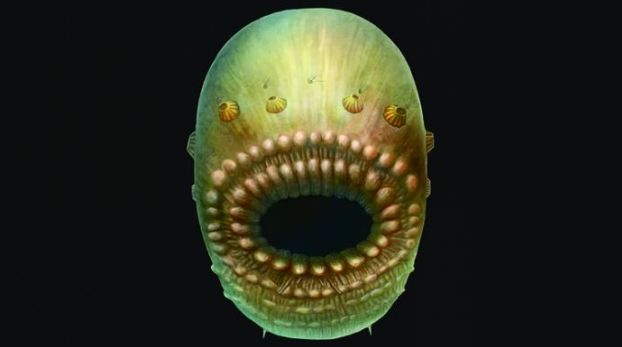A microscopic sea creature identified from fossils in China might be the earliest known step on an evolutionary path that eventually led to the emergence of humans
Researchers have identified traces of "Saccorhytus coronarius" -- a microscopic, bag-like sea creature that lived about 540 million years ago.
They believe this organism is the earliest known prehistoric ancestor of humans.
This organism was named Saccorhytus after the sack-like features created by its elliptical body and large mouth,
Saccorhytus is new to science and was identified from microfossils found in China. It is thought to be the most primitive example of a so-called "deuterostome" -- a broad biological category that encompasses a number of sub-groups, including vertebrates.
If the conclusions of the study published in the journal Nature, are correct, then Saccorhytus was the common ancestor of a huge range of species, and the earliest step yet discovered on the evolutionary path that eventually led to humans, hundreds of millions of years later.
The Saccorhytus microfossils were found in Shaanxi Province in central China. They pre-date all other known deuterostomes.
By isolating the fossils from the surrounding rock, and then studying them both under an electron microscope and using a CT scan, the team was able to build a picture of how Saccorhytus might have looked and lived. This revealed features and characteristics consistent with current assumptions about primitive deuterostomes.
The study suggests Saccorhytus' body was bilaterally symmetrical -- a characteristic inherited by many of its descendants, including humans -- and was covered with a thin, relatively flexible skin. This suggests it had some sort of musculature, leading the researchers to conclude that it could have made contractile movements, and got around by wriggling.
Perhaps its most striking feature, was its rather primitive means of eating food and then dispensing with the resulting waste. Saccorhytus had a large mouth, relative to the rest of its body, and probably ate by engulfing food particles, or even other creatures.
Saccorhytus was about a millimeter in size, and probably lived between grains of sand on the seabed. Its features were spectacularly preserved in the fossil record. Surprisingly, researchers were unable to find any evidence the animal had an anus.
But, as can be expected, modern humans are unlikely to perceive much by way of a family resemblance to this ugly thing.
The study was carried out by an international team of academics from the University of Cambridge in the UK and Northwest University in Xi'an China, with support from other colleagues at institutions in China and Germany.
"We think that as an early deuterostome this may represent the primitive beginnings of a very diverse range of species, including ourselves," said Simon Conway Morris, Professor of Evolutionary Palaeobiology and a Fellow of St John's College, University of Cambridge.
"To the naked eye, the fossils we studied look like tiny black grains, but under the microscope the level of detail is jaw-dropping. All deuterostomes had a common ancestor, and we think that is what we are looking at here."
Degan Shu from Northwest University said the team has made some important discoveries in the past, including the earliest fish and a remarkable variety of other early deuterostomes.
"Saccorhytus now gives us remarkable insights into the very first stages of the evolution of a group that led to the fish, and ultimately, to us."
Most other early deuterostome groups are from 510 to 520 million years ago, when they had already begun to diversify into not just the vertebrates, but the sea squirts, echinoderms (animals such as starfish and sea urchins) and hemichordates (a group including things like acorn worms).
This level of diversity has made it extremely difficult to work out what an earlier, common ancestor might have looked like.
"We had to process enormous volumes of limestone -- about three tonnes -- to get to the fossils, but a steady stream of new finds allowed us to tackle some key questions: Was this a very early echinoderm, or something even more primitive? The latter now seems to be the correct answer," said Dr. Jian Han of Northwest University.



























